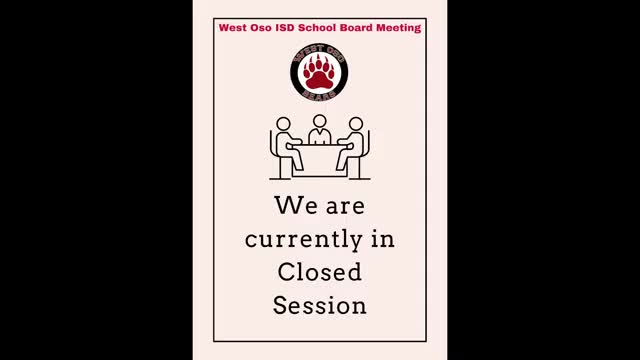Board hears junior-high improvement plan after concern over low outcomes; administrators promise targeted supports
October 07, 2025 | WEST OSO ISD, School Districts, Texas
This article was created by AI summarizing key points discussed. AI makes mistakes, so for full details and context, please refer to the video of the full meeting. Please report any errors so we can fix them. Report an error »

Board members focused substantial discussion on a junior-high campus identified by administrators as needing intensive support, including classroom routines, targeted tutoring and coaching.
Board concern and context
Board members said they were worried by year-end outcomes at one junior-high campus and said they did not want to see a repeat of a poor accountability rating. A board member told administrators, "I would be greatly disappointed if it happened again," and asked what will be done differently this year.
Assessment of causes and immediate responses
District staff said the junior-high issue reflects multiple causes: inconsistent classroom routines, administrative absences last year, and a need for stronger coaching and coordination. The district coordinator for school improvement (presented as the district's DCSI) said schoolwide routines and norms are being taught and reinforced so students know exactly what to do in the first five minutes of class and at transitions: "You have to teach them norms. Okay? You cannot just be roaming the hallways all day long."
Academic interventions and grants
Administrators described several instructional supports already in place or planned: Bluebonnet Learning and IXL for math and other subjects, Reading Renaissance (STAR) diagnostics, Accelerated Reader and high-impact tutoring programs (ACE High Impact Tutoring). They said the district will apply for federal/state learning-acceleration grants (LASSO series) that could fund a facilitator dedicated to the junior-high campus. Administrators also described weekly data reviews, beginning-of-year diagnostics and targeted progress-monitoring sheets for each class.
Teacher coaching and staffing
District leaders said they have reorganized grade-level assignments so teachers co-plan across two grades, added instructional-facilitator visits and will deploy peer observations and CNI (data) meetings. They reiterated the need for a consistent administrative team on campus and for central-office staff to increase on-site support while the campus recovers.
Why this matters
Board members noted long-term academic consequences for students who run into sustained gaps in reading and writing skills and said the district must ensure junior-high students enter high school with grade-level literacy and numeracy or remediation plans that produce verified gains.
Next steps and monitoring
Administrators said they will increase presence at the junior high, continue diagnostic testing and progress monitoring, apply for grants for a dedicated facilitator and provide weekly data updates to central office. The district said it will not wait until midyear to address underperforming teachers and will use walk-throughs, coaching and professional development immediately.
Board concern and context
Board members said they were worried by year-end outcomes at one junior-high campus and said they did not want to see a repeat of a poor accountability rating. A board member told administrators, "I would be greatly disappointed if it happened again," and asked what will be done differently this year.
Assessment of causes and immediate responses
District staff said the junior-high issue reflects multiple causes: inconsistent classroom routines, administrative absences last year, and a need for stronger coaching and coordination. The district coordinator for school improvement (presented as the district's DCSI) said schoolwide routines and norms are being taught and reinforced so students know exactly what to do in the first five minutes of class and at transitions: "You have to teach them norms. Okay? You cannot just be roaming the hallways all day long."
Academic interventions and grants
Administrators described several instructional supports already in place or planned: Bluebonnet Learning and IXL for math and other subjects, Reading Renaissance (STAR) diagnostics, Accelerated Reader and high-impact tutoring programs (ACE High Impact Tutoring). They said the district will apply for federal/state learning-acceleration grants (LASSO series) that could fund a facilitator dedicated to the junior-high campus. Administrators also described weekly data reviews, beginning-of-year diagnostics and targeted progress-monitoring sheets for each class.
Teacher coaching and staffing
District leaders said they have reorganized grade-level assignments so teachers co-plan across two grades, added instructional-facilitator visits and will deploy peer observations and CNI (data) meetings. They reiterated the need for a consistent administrative team on campus and for central-office staff to increase on-site support while the campus recovers.
Why this matters
Board members noted long-term academic consequences for students who run into sustained gaps in reading and writing skills and said the district must ensure junior-high students enter high school with grade-level literacy and numeracy or remediation plans that produce verified gains.
Next steps and monitoring
Administrators said they will increase presence at the junior high, continue diagnostic testing and progress monitoring, apply for grants for a dedicated facilitator and provide weekly data updates to central office. The district said it will not wait until midyear to address underperforming teachers and will use walk-throughs, coaching and professional development immediately.
Don't Miss a Word: See the Full Meeting!
Go beyond summaries. Unlock every video, transcript, and key insight with a Founder Membership.
✓
Get instant access to full meeting videos
✓
Search and clip any phrase from complete transcripts
✓
Receive AI-powered summaries & custom alerts
✓
Enjoy lifetime, unrestricted access to government data
30-day money-back guarantee

